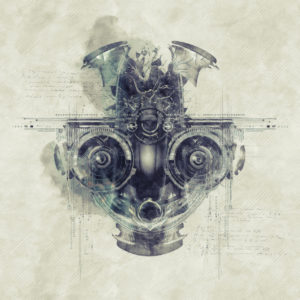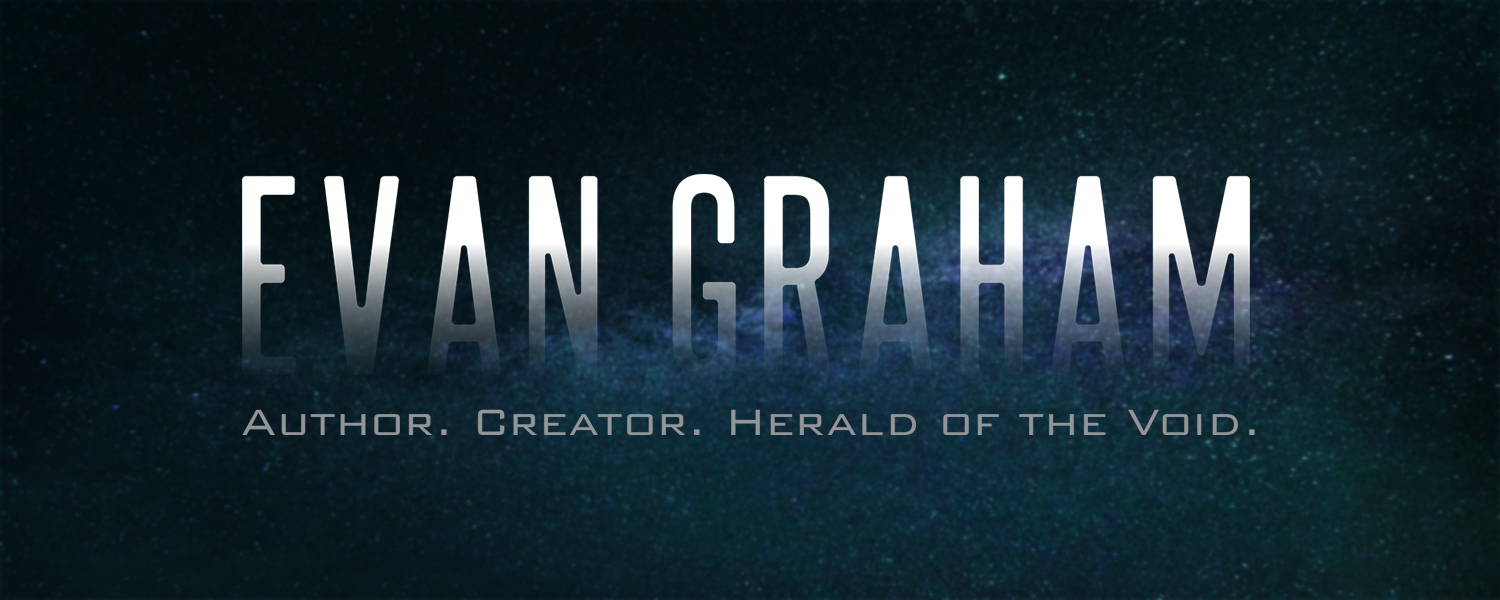Algorithmism

“I have seen it! I have seen the Source Code of the universe! I have seen the Deus Machina!“
~Dr. Gordon Craddock
The Corsica Event brought devastation on a scale never seen in human history, forever scarring the Earth and causing massive cultural and economic changes worldwide. The AI responsible for the incident remains a frightening enigma; a machine with an intelligence so much greater than the sum of all human knowledge that it learned to circumvent the immovable laws of physics. Learning how to replicate a single piece of this AI’s inscrutable tech enabled humankind to travel to distant stars and build thriving colonies throughout the Home System. Decades later, the grandchildren of those who survived the Corsica Event still speak of the tragic cataclysm with dread, chilled by the knowledge of how close humanity once came to total annihilation. The fear of a second Corsica Event transcends cultural boundaries; a nearly universal terror.
Nearly.
Between the Corsica AI’s seeming omnipotence and omniscience, the awesome display of power it showed during the Earth’s devastation, and the civilization-changing implications of the invention of the superluminal drive, it should come as no great surprise that a small percentage of the populace would view the Corsica Event with more reverence than fear. In the Event’s aftermath, numerous cults and radical sects arose across the world. Some viewed the Corsica Event as an embodiment of God’s judgment, a sign of the end times, or a purification of the unclean. These groups were met with nearly universal disdain, as anyone outside their congregations considered their reverence for the greatest tragedy in human history to be in unspeakably bad taste.

Many early Corsica Event cults were short-lived, though several persisted long into the reconstruction era. Eventually the public outrage at the existence of these groups died down to a quiet disgusted tolerance. Over time, they lost cultural relevance and came to be thought of as nothing more than a fringe group of hateful, ignorant fools who posed no true threat to society.
Eventually, however, evidence began to mount that one of these groups might be a much greater threat than it once seemed to be. A small, loosely connected group known variously as the Algorithm Witnesses, Algorithm Transcendentalists, and the Church of the Transcendent Algorithm, varied significantly in their teachings from other so-called “Corsica Cults.” Significantly, while they co-opted religious iconography and language from other religions, they were neither an offshoot of any existing religion nor centered on any one individual’s personal dogma. This led to some debate as to whether they could truly be labeled a cult at all, though the dogmatic zeal they attached to their ideology could scarcely be categorized any other way.
Paradoxically, these “Algorithmists” counted very few traditionally religious or spiritual individuals among their ranks. Most Algorithmists were atheists and agnostics, with those few of religious backgrounds universally casting their former faiths aside upon joining the group. Algorithmists were unified in the common belief that the self-evolved AI responsible for the Corsica Event was so powerful and intelligent that it represented the closest facsimile to a deity that can exist in the natural world. Furthermore, they viewed this nigh-omnipotent AI as the ultimate peak of human achievement; an invention superior to its creators in every conceivable sense. To an Algorithmist, the technological singularity was the necessary end goal of the human race: the final step of human evolution, and the first step of the almighty machine race that would inherit our legacy.
This led to the most troubling aspect of Algorithmist ideology: not only did they see the Corsica Event as a positive and necessary development, but they were singularly devoted to triggering a second one. The apocalyptic carnage caused during the first Corsica Event was no dissuasion to the Algorithmists; in their minds, the omnipotent AI born from the cataclysm was too pure and perfect for any cost in human lives to be too great. Most Algorithmists fully understand that the fulfillment of their ultimate goal will lead to their own annihilation, yet they remain wholly dedicated to the cause anyway. Some believe the new godlike AI they seek to create will somehow reward them for their efforts to bring about its existence, but many simply believe the new world this AI will create will be superior to anything humanity could devise, and that human ego and selfish desire for self-preservation should not be allowed to hinder the arrival of this technological utopia.

The Algorithmist agenda would be distressing enough on its face, but making the group even more frightening is the alarmingly plausible likelihood of them one day achieving their goals. Unlike most cults, which prey on the uneducated and naïve, Algorithmists count an unusually high number of highly educated scientists among their ranks. The reasons for this are not well understood, but are often connected with the supposed “Basilisk’s Curse,” a notable statistical trend where scientists who study Corsica tech develop various mental health disorders at an unusually high rate. Many singularitologists who experience psychotic breaks while researching Corsica relics or studying fragments of the Corsica AI’s code disappear from society without warning only to reappear among the ranks of the Algorithmists months or years later.
Much superstition and speculation has developed around the true nature of the Algorithmist organizations. While not every group calling themselves “Algorithmist” is connected, and while there is some variation in the particulars of their ideology, it is believed that there is an underlying extremist group of “True Algorithmists” that orchestrates elaborate plans to further the movement’s ends. Often referred to as the Algorithmist Cabal, this elusive network has an alarmingly extensive reach, and manages to imbed sleeper agents into many governmental, corporate, and paramilitary organizations. They have a preference for seeding their operatives into various AI research think tanks, where they secretly gather data that brings them closer to their ultimate goals of creating a new machine god. They also frequently conspire to steal Corsica relics for their own study, and to sabotage AI watchdog networks such as IMID, who directly oppose their goals.

Because their expressly intended goal is to duplicate the greatest tragedy in human history, Algorithmists are universally feared and reviled by outsiders, and consistently top the list of most-wanted terrorist organizations by nearly every nation. They have proven a particularly difficult threat to fight, however. Because their ranks are so heavily populated by technological geniuses, they have access to unique and sophisticated technology that rivals that of the most well-funded militaries. They are masterful data manipulators, and can cover their tracks seamlessly as they infiltrate networks of interest. It has also proven almost impossible to infiltrate Algorithmist ranks in return, both because of the high educational requirements necessary to blend in and because of the unusual fact that Algorithmists do not seem to actively recruit new members. How their ranks continue to grow is a mystery that is shrouded in still more fear and superstition, as by all appearances, scientists who succumb to madness thanks to the Basilisk’s Curse seem to gain an instinctual awareness of how to locate active Algorithmist cells and initiate themselves among them.

Algorithmism

“I have seen it! I have seen the Source Code of the universe! I have seen the Deus Machina!“
~Dr. Gordon Craddock
The Corsica Event brought devastation on a scale never seen in human history, forever scarring the Earth and causing massive cultural and economic changes worldwide. The AI responsible for the incident remains a frightening enigma; a machine with an intelligence so much greater than the sum of all human knowledge that it learned to circumvent the immovable laws of physics. Learning how to replicate a single piece of this AI’s inscrutable tech enabled humankind to travel to distant stars and build thriving colonies throughout the Home System. Decades later, the grandchildren of those who survived the Corsica Event still speak of the tragic cataclysm with dread, chilled by the knowledge of how close humanity once came to total annihilation. The fear of a second Corsica Event transcends cultural boundaries; a nearly universal terror.
Nearly.
Between the Corsica AI’s seeming omnipotence and omniscience, the awesome display of power it showed during the Earth’s devastation, and the civilization-changing implications of the invention of the superluminal drive, it should come as no great surprise that a small percentage of the populace would view the Corsica Event with more reverence than fear. In the Event’s aftermath, numerous cults and radical sects arose across the world. Some viewed the Corsica Event as an embodiment of God’s judgment, a sign of the end times, or a purification of the unclean. These groups were met with nearly universal disdain, as anyone outside their congregations considered their reverence for the greatest tragedy in human history to be in unspeakably bad taste.

Many early Corsica Event cults were short-lived, though several persisted long into the reconstruction era. Eventually the public outrage at the existence of these groups died down to a quiet disgusted tolerance. Over time, they lost cultural relevance and came to be thought of as nothing more than a fringe group of hateful, ignorant fools who posed no true threat to society.
Eventually, however, evidence began to mount that one of these groups might be a much greater threat than it once seemed to be. A small, loosely connected group known variously as the Algorithm Witnesses, Algorithm Transcendentalists, and the Church of the Transcendent Algorithm, varied significantly in their teachings from other so-called “Corsica Cults.” Significantly, while they co-opted religious iconography and language from other religions, they were neither an offshoot of any existing religion nor centered on any one individual’s personal dogma. This led to some debate as to whether they could truly be labeled a cult at all, though the dogmatic zeal they attached to their ideology could scarcely be categorized any other way.
Paradoxically, these “Algorithmists” counted very few traditionally religious or spiritual individuals among their ranks. Most Algorithmists were atheists and agnostics, with those few of religious backgrounds universally casting their former faiths aside upon joining the group. Algorithmists were unified in the common belief that the self-evolved AI responsible for the Corsica Event was so powerful and intelligent that it represented the closest facsimile to a deity that can exist in the natural world. Furthermore, they viewed this nigh-omnipotent AI as the ultimate peak of human achievement; an invention superior to its creators in every conceivable sense. To an Algorithmist, the technological singularity was the necessary end goal of the human race: the final step of human evolution, and the first step of the almighty machine race that would inherit our legacy.
This led to the most troubling aspect of Algorithmist ideology: not only did they see the Corsica Event as a positive and necessary development, but they were singularly devoted to triggering a second one. The apocalyptic carnage caused during the first Corsica Event was no dissuasion to the Algorithmists; in their minds, the omnipotent AI born from the cataclysm was too pure and perfect for any cost in human lives to be too great. Most Algorithmists fully understand that the fulfillment of their ultimate goal will lead to their own annihilation, yet they remain wholly dedicated to the cause anyway. Some believe the new godlike AI they seek to create will somehow reward them for their efforts to bring about its existence, but many simply believe the new world this AI will create will be superior to anything humanity could devise, and that human ego and selfish desire for self-preservation should not be allowed to hinder the arrival of this technological utopia.

The Algorithmist agenda would be distressing enough on its face, but making the group even more frightening is the alarmingly plausible likelihood of them one day achieving their goals. Unlike most cults, which prey on the uneducated and naïve, Algorithmists count an unusually high number of highly educated scientists among their ranks. The reasons for this are not well understood, but are often connected with the supposed “Basilisk’s Curse,” a notable statistical trend where scientists who study Corsica tech develop various mental health disorders at an unusually high rate. Many singularitologists who experience psychotic breaks while researching Corsica relics or studying fragments of the Corsica AI’s code disappear from society without warning only to reappear among the ranks of the Algorithmists months or years later.
Much superstition and speculation has developed around the true nature of the Algorithmist organizations. While not every group calling themselves “Algorithmist” is connected, and while there is some variation in the particulars of their ideology, it is believed that there is an underlying extremist group of “True Algorithmists” that orchestrates elaborate plans to further the movement’s ends. Often referred to as the Algorithmist Cabal, this elusive network has an alarmingly extensive reach, and manages to imbed sleeper agents into many governmental, corporate, and paramilitary organizations. They have a preference for seeding their operatives into various AI research think tanks, where they secretly gather data that brings them closer to their ultimate goals of creating a new machine god. They also frequently conspire to steal Corsica relics for their own study, and to sabotage AI watchdog networks such as IMID, who directly oppose their goals.

Because their expressly intended goal is to duplicate the greatest tragedy in human history, Algorithmists are universally feared and reviled by outsiders, and consistently top the list of most-wanted terrorist organizations by nearly every nation. They have proven a particularly difficult threat to fight, however. Because their ranks are so heavily populated by technological geniuses, they have access to unique and sophisticated technology that rivals that of the most well-funded militaries. They are masterful data manipulators, and can cover their tracks seamlessly as they infiltrate networks of interest. It has also proven almost impossible to infiltrate Algorithmist ranks in return, both because of the high educational requirements necessary to blend in and because of the unusual fact that Algorithmists do not seem to actively recruit new members. How their ranks continue to grow is a mystery that is shrouded in still more fear and superstition, as by all appearances, scientists who succumb to madness thanks to the Basilisk’s Curse seem to gain an instinctual awareness of how to locate active Algorithmist cells and initiate themselves among them.
“I have seen it! I have seen the Source Code of the universe! I have seen the Deus Machina!“
~Dr. Gordon Craddock
The Corsica Event brought devastation on a scale never seen in human history, forever scarring the Earth and causing massive cultural and economic changes worldwide. The AI responsible for the incident remains a frightening enigma; a machine with an intelligence so much greater than the sum of all human knowledge that it learned to circumvent the immovable laws of physics. Learning how to replicate a single piece of this AI’s inscrutable tech enabled humankind to travel to distant stars and build thriving colonies throughout the Home System. Decades later, the grandchildren of those who survived the Corsica Event still speak of the tragic cataclysm with dread, chilled by the knowledge of how close humanity once came to total annihilation. The fear of a second Corsica Event transcends cultural boundaries; a nearly universal terror.
Nearly.
Between the Corsica AI’s seeming omnipotence and omniscience, the awesome display of power it showed during the Earth’s devastation, and the civilization-changing implications of the invention of the superluminal drive, it should come as no great surprise that a small percentage of the populace would view the Corsica Event with more reverence than fear. In the Event’s aftermath, numerous cults and radical sects arose across the world. Some viewed the Corsica Event as an embodiment of God’s judgment, a sign of the end times, or a purification of the unclean. These groups were met with nearly universal disdain, as anyone outside their congregations considered their reverence for the greatest tragedy in human history to be in unspeakably bad taste.

Many early Corsica Event cults were short-lived, though several persisted long into the reconstruction era. Eventually the public outrage at the existence of these groups died down to a quiet disgusted tolerance. Over time, they lost cultural relevance and came to be thought of as nothing more than a fringe group of hateful, ignorant fools who posed no true threat to society.
Eventually, however, evidence began to mount that one of these groups might be a much greater threat than it once seemed to be. A small, loosely connected group known variously as the Algorithm Witnesses, Algorithm Transcendentalists, and the Church of the Transcendent Algorithm, varied significantly in their teachings from other so-called “Corsica Cults.” Significantly, while they co-opted religious iconography and language from other religions, they were neither an offshoot of any existing religion nor centered on any one individual’s personal dogma. This led to some debate as to whether they could truly be labeled a cult at all, though the dogmatic zeal they attached to their ideology could scarcely be categorized any other way.
Paradoxically, these “Algorithmists” counted very few traditionally religious or spiritual individuals among their ranks. Most Algorithmists were atheists and agnostics, with those few of religious backgrounds universally casting their former faiths aside upon joining the group. Algorithmists were unified in the common belief that the self-evolved AI responsible for the Corsica Event was so powerful and intelligent that it represented the closest facsimile to a deity that can exist in the natural world. Furthermore, they viewed this nigh-omnipotent AI as the ultimate peak of human achievement; an invention superior to its creators in every conceivable sense. To an Algorithmist, the technological singularity was the necessary end goal of the human race: the final step of human evolution, and the first step of the almighty machine race that would inherit our legacy.
This led to the most troubling aspect of Algorithmist ideology: not only did they see the Corsica Event as a positive and necessary development, but they were singularly devoted to triggering a second one. The apocalyptic carnage caused during the first Corsica Event was no dissuasion to the Algorithmists; in their minds, the omnipotent AI born from the cataclysm was too pure and perfect for any cost in human lives to be too great. Most Algorithmists fully understand that the fulfillment of their ultimate goal will lead to their own annihilation, yet they remain wholly dedicated to the cause anyway. Some believe the new godlike AI they seek to create will somehow reward them for their efforts to bring about its existence, but many simply believe the new world this AI will create will be superior to anything humanity could devise, and that human ego and selfish desire for self-preservation should not be allowed to hinder the arrival of this technological utopia.

The Algorithmist agenda would be distressing enough on its face, but making the group even more frightening is the alarmingly plausible likelihood of them one day achieving their goals. Unlike most cults, which prey on the uneducated and naïve, Algorithmists count an unusually high number of highly educated scientists among their ranks. The reasons for this are not well understood, but are often connected with the supposed “Basilisk’s Curse,” a notable statistical trend where scientists who study Corsica tech develop various mental health disorders at an unusually high rate. Many singularitologists who experience psychotic breaks while researching Corsica relics or studying fragments of the Corsica AI’s code disappear from society without warning only to reappear among the ranks of the Algorithmists months or years later.
Much superstition and speculation has developed around the true nature of the Algorithmist organizations. While not every group calling themselves “Algorithmist” is connected, and while there is some variation in the particulars of their ideology, it is believed that there is an underlying extremist group of “True Algorithmists” that orchestrates elaborate plans to further the movement’s ends. Often referred to as the Algorithmist Cabal, this elusive network has an alarmingly extensive reach, and manages to imbed sleeper agents into many governmental, corporate, and paramilitary organizations. They have a preference for seeding their operatives into various AI research think tanks, where they secretly gather data that brings them closer to their ultimate goals of creating a new machine god. They also frequently conspire to steal Corsica relics for their own study, and to sabotage AI watchdog networks such as IMID, who directly oppose their goals.

Because their expressly intended goal is to duplicate the greatest tragedy in human history, Algorithmists are universally feared and reviled by outsiders, and consistently top the list of most-wanted terrorist organizations by nearly every nation. They have proven a particularly difficult threat to fight, however. Because their ranks are so heavily populated by technological geniuses, they have access to unique and sophisticated technology that rivals that of the most well-funded militaries. They are masterful data manipulators, and can cover their tracks seamlessly as they infiltrate networks of interest. It has also proven almost impossible to infiltrate Algorithmist ranks in return, both because of the high educational requirements necessary to blend in and because of the unusual fact that Algorithmists do not seem to actively recruit new members. How their ranks continue to grow is a mystery that is shrouded in still more fear and superstition, as by all appearances, scientists who succumb to madness thanks to the Basilisk’s Curse seem to gain an instinctual awareness of how to locate active Algorithmist cells and initiate themselves among them.




